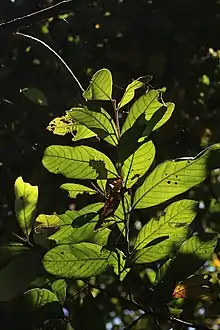| Cryptocarya anamalayana | |
|---|---|
 | |
| Scientific classification | |
| Kingdom: | Plantae |
| Clade: | Tracheophytes |
| Clade: | Angiosperms |
| Clade: | Magnoliids |
| Order: | Laurales |
| Family: | Lauraceae |
| Genus: | Cryptocarya |
| Species: | C. anamalayana |
| Binomial name | |
| Cryptocarya anamalayana | |
Cryptocarya anamalayana is a rare rainforest tree endemic to the southern Western Ghats, India.[2] The specific epithet of the name refers to the Anamalai Hills, a major area of its distribution. The species considered endangered under the IUCN Red List of Threatened Species.[1]
Description

Small, rare evergreen trees up to 8 metres tall with greyish-brown, smooth bark and characteristic fulvous tomentose branchlets, young shoots, and leaves. The thick, coriaceous leaves are simple, alternate, and spirally arranged on the branchlets, with petioles about 1.2 cm long and a leaf blade of 8.5-20 cm length by 3.5-9 cm width. The leaf shape is elliptic-oblong and it has a sharp acuminate apex, while the base is acute or rounded. The leaves are pale glaucous beneath. The nerves are fulvous tomentose on both sides of the leaves and the midrib is raised. About 8 pairs of secondary nerves are there in each leaf and the tertiary nerves are distinct and obliquely parallel.[3][4] The flowers are bisexual, arranged in short cymose panicles (also fulvous tomentose) upto 3 cm long, with prominent oblong bracts and bracteoles that are apparently persistent. The flowers have 9 stamens in 3 rows, with 2-celled anthers. The ovary is sessile, half inferior with a short, exserted style. The fruit is a drupe, with a single seed.[3][4] The fruit is oblong and has 10-12 ridges along its length (2.5-4.0 cm long × 0.8–1.3 cm wide) and is obtuse at its ends, sparsely hairy, light to bright green when young and glossy black when ripe.[5]
Distribution
Endemic to the southern ranges of the Western Ghats from the Agasthyamalai region in the south,[6] through Periyar and Anamalai.[3]
Habitat
Found in medium-elevation tropical wet evergreen forests between 1000 and 1400 m.[3] It is reported to be very rare in evergreen and wet evergreen forests on hill slopes between 600 and 1200 m in four disjunct locations along the southern Western Ghats.[5]
Ecology
These are rare understorey trees in tropical wet evergreen forest. The species is reported to flower and fruit between April and August.[5]
Gallery
 Branchlets
Branchlets Leaves
Leaves Underside of leaves
Underside of leaves Close up of inflorescence
Close up of inflorescence Fruits
Fruits Branchlet with fruits
Branchlet with fruits Herbarium specimen from the Anamalai Hills
Herbarium specimen from the Anamalai Hills
References
- 1 2 de Kok, R.; Amitha Bachan, K.H. (2021). "Cryptocarya anamalayana". IUCN Red List of Threatened Species. 2021: e.T38783A138508350. doi:10.2305/IUCN.UK.2021-3.RLTS.T38783A138508350.en. Retrieved 23 August 2023.
- ↑ "Cryptocarya anamalayana Gamble | Plants of the World Online | Kew Science". Plants of the World Online. Retrieved 4 August 2022.
- 1 2 3 4 "Cryptocarya anamalayana - LAURACEAE". www.biotik.org. Retrieved 4 August 2022.
- 1 2 "Cryptocarya anamalayana". India Biodiversity Portal. 2022. Retrieved 4 August 2022.
- 1 2 3 Robi, A.J.; Bachan, K.H.A.; Pradeep, A.K.; Udayan, P.S. (2018). "Lectotypification of Cryptocarya anamalayana Gamble (Lauraceae) with a note on its fruits". Bangladesh Journal of Plant Taxonomy. 25: 107–111. doi:10.3329/bjpt.v25i1.37187. S2CID 89706600.
- ↑ Richard, Paulraj Selva Singh; Muthukumar, Selvaraj Abraham (1 September 2012). "Arborescent angiosperms of Mundanthurai Range in the Kalakad-Mundanthurai Tiger Reserve (KMTR) of the southern Western Ghats, India". Check List. 8 (5): 951. doi:10.15560/8.5.951. ISSN 1809-127X.
